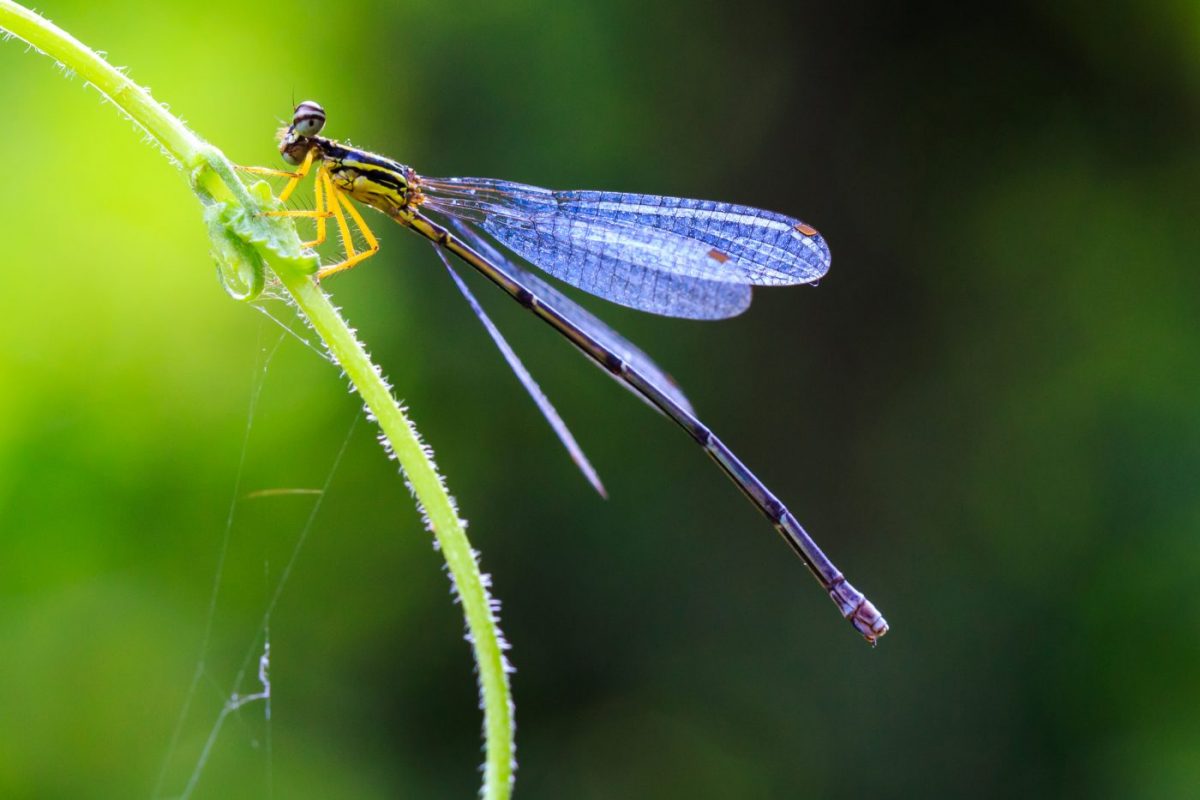A Damselfly Dances in the Face of Ableism

As we drove into the parking lot adjacent to a tried and true trailhead, the hollow moon had climbed into the bluest corner of the sky. Drifting thunderheads were perched atop the distant tree line like pensive giants.
“Beautiful day for a hike,” I said to my companion, Andy, as the mist of mosquito repellent swathed our skin. Mosquitoes thrive like ravenous vampires in the swampy air and unbridled heat of Wisconsin summers. Since swatting at them in slow motion isn’t the most effective control mechanism, I rely on the mighty forces of repellent to suppress their appetite.
The trail we were embarking on was an old favorite because it boasted an enthralling combination of scenery, accessibility, wildlife, and seclusion. With a relatively smooth base of compacted gravel for the entire duration, the wide pathway twisted and turned along the craggy banks of the Wisconsin River. I enjoy trails that are mostly level and can be navigated by my wheelchair with ease because I can go longer distances without feeling neck and trunk fatigue.
We crossed a boardwalk and rounded a bend of enchanting forest to greet the river. Brilliant blue clusters of damselflies danced amid rose gold sunbeams that peeked through vacancies in the leafy canopy above us. The damselfly has a weaker, more delicate flight pattern than that of its robust dragonfly relatives. Descending from an archaic lineage that dates back millions of years, the damselfly thrives with shimmering wings, a body of galvanized beauty, and an old soul.
When I think about the damselfly, I relate to how freely I move along the most accessible trails. They allow me to explore at a pace that is aligned with my own organic motion. I can venture swiftly as a dazzling maven of maneuverability. My wheelchair feels natural to me; I don’t feel bound or tethered to it. My wheelchair is the vessel that helps me to engage in adventure. When my wheels are unobstructed, so is my spirit.
At an upcoming curve, I spotted a group of cyclists speeding our direction. We moved to the far right portion of the trail before they whizzed past us, exchanging socially distanced nods and friendly smiles.
Taking notice of my wheelchair, the last cyclist blurted out a comment as familiar and off-putting to me as the childhood taste of bitter cough syrup: “Hey, I gotta get me one of those things!”
His bicycle chain outpaced my own wit and hauled him into the distance before I had a chance to process his words. I glanced at the blackberry bush beside me, its sweet fruition entangled with protruding thorns in the same manner that our pleasant hike had been pierced by words of ignorance.
We carried on for a moment until Andy broke the silence, “Why do some people say things like that without any sense of a filter?”
“I don’t know. But it’s been a part of my life for as long as I can remember,” I said. “Even as a kid, there was this older man in my town who was known for being a jokester toward everyone. Every single time he would see me, he’d make an obnoxious comment about my wheelchair, calling me Evel Knievel.”
We both laughed at the multifaceted ridiculousness of it and shook our heads.
“And I remember how crimson my cheeks would flush in embarrassment. My mom and grandparents would downplay it to comfort me, telling me it was just his way of trying to make people smile and laugh. I don’t know how much it was related to growing up in a small town. Big city, small town. It doesn’t seem to matter sometimes. It depends more on the degree to which a person considers what they are actually saying to someone with a disability.”
To understand something and encourage change, we must first acknowledge and see it. I don’t merely wish for those of us with disabilities to be noticed, I wish to be sincerely understood. I’m often meandering between the desire to be seen, and the trepidation of being confronted with microaggressions by ableist perspectives.
I lifted my eyes toward the sun that was ablaze in the sky and thought about the gradient of heat it emits. Some of the comments I’ve encountered fall along the cooler regions of the atmosphere. They’re small sparks of discomfort that, while annoying, are quickly extinguished by positivity. Others will blister on contact, scorching the edges of my story’s pages in attempt to devalue its overall worth.
Engaging in daily affirmations of self-acceptance is a habitual practice of resiliency. While my bodily strength and physical abilities may not match that of my peers, I am a beautiful damselfly, nonetheless. I seek out the light and dance in the face of ableism.
***
Note: SMA News Today is strictly a news and information website about the disease. It does not provide medical advice, diagnosis, or treatment. This content is not intended to be a substitute for professional medical advice, diagnosis, or treatment. Always seek the advice of your physician or other qualified health provider with any questions you may have regarding a medical condition. Never disregard professional medical advice or delay in seeking it because of something you have read on this website. The opinions expressed in this column are not those of SMA News Today, or its parent company, Bionews Services, and are intended to spark discussion about issues pertaining to spinal muscular atrophy.








Leave a comment
Fill in the required fields to post. Your email address will not be published.